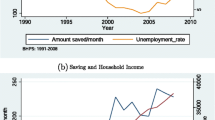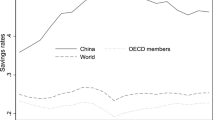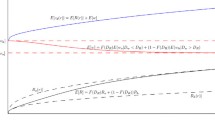Abstract
This paper examines the relative savings position of migrant households in West Germany paying particular attention to differences between temporary and permanent migrants. Our findings reveal significant differences in the savings rates between German natives and immigrants. If remittances are treated as savings, however, migrants who intend to return to their home country save significantly more than comparable natives. The results of a decomposition analysis indicate that slightly more than half of the differences in the savings rate between Germans and permanent migrants and almost 70% between temporary and permanent migrants can be attributed to differences in observable characteristics.

Similar content being viewed by others
Notes
The data used in this paper were extracted from the SOEP Database provided by the DIW Berlin (http://www.diw.de/soep) using the Add-On package SOEP Menu v2.0 (Jul 2005) for Stata(R). SOEP Menu was written by Dr. John P. Haisken-DeNew (john@soepmenu.de). John P. Haisken-DeNew and Markus Hahn supplied the SOEP Menu Plugins used to ensure longitudinal consistency. The SOEP Menu generated DO file to retrieve the SOEP data used here, and any SOEP Menu Plugins are available upon request. Any data or computational errors in this paper are our own. Haisken-DeNew (2005) describes SOEP Menu in detail.
We also ran regressions in which we considered the remittances of permanent immigrants as savings. This procedure did not change our results qualitatively. The estimates are available from the authors upon request.
Note that the decomposition equation may also be written as \( \Delta^{\text{OLS}}_{nm } = (\overline{\mathbf{X}}_n - \overline{\mathbf{X}}_m)\widehat{\beta}_m + \overline{\mathbf{X}}_n (\widehat{\beta}_n - \widehat{\beta}_m).\) We calculated both versions of the decomposition equation. Since we find that the estimates derived from the two equations do not differ substantially from each other, we focus on Eq. 5 throughout the paper.
To account for the variation in return intentions over time, we carried out alternative estimations, restricting the sample of immigrants to those persons who never change their return intention. This restriction reduced the sample to 6,190 (38,258) person-year observations with 1,079 (4,405) immigrants for the years 1993 and 1995 (for the period from 1996 to 2004). The estimates derived from this sample do not differ significantly from those presented in Table 2. They are available from the authors upon request.
The effect of immigration for the average household may be calculated as \(\omega_1 - \omega_0 = (\widehat{\gamma}_0 + \widehat{\gamma}_2 \times 1 + \overline{\mathbf{Z}} \widehat{\gamma}_3 + \widehat{\gamma}_4 \overline{R} + \widehat{\gamma}_5 \overline{YOM}) - (\widehat{\gamma}_0 + \widehat{\gamma}_2 \times 0) = \widehat{\gamma}_2 + \overline{\mathbf{Z}} \widehat{\gamma}_3 + \widehat{\gamma}_4 \overline{R} + \widehat{\gamma}_5 \overline{YOM}\) for the sample of immigrant households (M i = 1). The average effect of return intentions is given by \(\omega_3 - \omega_2 = (\widehat{\gamma}_0 + \widehat{\gamma}_2 \times 1 + \overline{\mathbf{Z}} \widehat{\gamma}_3 + \widehat{\gamma}_4 \times 1 + \widehat{\gamma}_5 \overline{YOM}) - (\widehat{\gamma}_0 + \widehat{\gamma}_2 \times 1 + \widehat{\gamma}_4 \times 0)= \overline{\mathbf{Z}} \widehat{\gamma}_3 + \widehat{\gamma}_4 + \widehat{\gamma}_5 \overline{YOM}\). The corresponding marginal effects of the Tobit model are p j − p j − 1 (the probability of being uncensored), e j − e j − 1 (the conditional expectation), and \(y^*_j - y^*_{j-1}\) (the unconditional expectation) for j = {1,3 }, where \(p_k = \Phi(\omega_k / \widehat{\sigma})\), \(e_k = \omega_k + \widehat{\sigma} \frac{\phi(\omega_k/\widehat{\sigma})}{\Phi(\omega_k/\widehat{\sigma})}\), and \(y^*_k = e_k p_k\) (k = {j, j − 1 }). The authors are grateful to an anonymous referee for this indication.
The underlying estimates of the decomposition analysis in Table 4 are available upon request.
Note that for permanent migrants, differences between Savings rate I and Savings rate IIa are very small, while differences between Savings rate I and Savings rate IIb do not exist (see Table 6 of “Appendix”). For that reason, differences in Savings rate II between natives and permanent migrants are not considered in the decomposition analysis.
This result is in line with our estimates of the determinants of the savings rate, where the existence of children has no statistical significant different impact on the savings rate of immigrant and native households.
The data are available from the Development Education Program of the World Bank.
References
Amuedo-Dorantes C, Pozo S (2002) Precautionary saving by young immigrants and young natives. South Econ J 69(1):48–71
Amuedo-Dorantes C, Pozo S (2006) Remittances as insurance: evidence from Mexican immigrants. J Popul Econ 19(2):227–254
Atkinson AB, Rainwater L, Smeeding TM (1995) Income distribution in the OECD countries. In: Social policy studies, vol 18. OCED, Paris
Bauer TK (2002) Migration, Sozialstaat und Zuwanderungspolitik. Vierteljahreshefte zur Wirtschaftsforschung 71(2):249–271
Bauer TK, Sinning MG (2010) Blinder–Oaxaca decomposition for Tobit models. Appl Econ (in press)
Bauer TK, Dietz B, Zimmermann KF, Zwintz E (2005) German migration: development, assimilation, and labor market effects. In: Zimmermann KF (ed) European migration: what do we know? Oxford University Press, Oxford, pp 197–261
Blinder AS (1973) Wage discrimination: reduced form and structural estimates. J Hum Resour 8(4):436–455
Borjas GJ (1987) Self-selection and the earnings of immigrants. Am Econ Rev 77(4):531–553
Borjas GJ (1994) The economics of immigration. J Econ Lit 32(4):1667–1717
Carroll C, Rhee B, Rhee C (1994) Are there cultural effects on saving? Some cross-sectional evidence. Q J Econ 109(3):685–699
Chiswick BR (1978) The effect of Americanization on the earnings of foreign-born men. J Polit Econ 86(5):897–921
Chiteji NS, Stafford FP (1999) Portfolio choices of parents and their children as young adults: asset accumulation by African-American families. Am Econ Rev 89(2):377–380
Cobb-Clark DA, Hildebrand VA (2006) The wealth and asset holdings of U.S.-born and foreign-born households: evidence from SIPP data. Rev Income Wealth 52(1):17–42
Djajic S (1989) Migrants in a guest-worker system: a utility maximizing approach. J Dev Econ 31(2):327–339
Djajic S, Milbourne R (1988) A general equilibrium model of guest-worker migration. J Int Econ 25(3–4):335–351
Dustmann C (1997) Return migration, uncertainty and precautionary savings. J Dev Econ 52(2):295–316
Feldstein M, Pellechio A (1979) Social security and household wealth accumulation: new microeconometric evidence. Rev Econ Stat 61(3):361–368
Fertig M, Schmidt CM (2002) First- and second-generation migrants in Germany—what do we know and what do people think. In: Rotte R, Stein P (eds) Migration policy and the economy: international experiences. Hans-Seidel-Stiftung, Studies and Comments, Bd. 1, Munich, pp 179–218
Fricke C, Frick JR, Wagner GG (2004) Sparen und Verschuldung privater Haushalte. In: Statistisches Bundesamt (ed) Datenreport 2004—Zahlen und Fakten über die Bundesrepublik Deutschland. Bundeszentrale für politische Bildung, Bonn, pp 595–602
Galor O, Stark O (1990) Migrants’ savings, the probability of return migration and migrants’ performance. Int Econ Rev 31(2):463–467
Haisken-DeNew JP (2005) SOEPmenu: a menu-driven stata/SE interface for accessing the German socio-economic panel. Mimeo
McDonald JF, Moffitt RA (1980) The uses of Tobit analysis. Rev Econ Stat 62(2):318–321
Merkle L, Zimmermann KF (1992) Savings, remittances, and return migration. Econ Lett 38(1):77–81
Oaxaca RL (1973) Male–female wage differentials in urban labor markets. Int Econ Rev 14(3):693–709
Riphahn R (1998) Immigrant participation in the German welfare program. Finanzarchiv 55(2):163–185
Schwarz N (2001) The German microcensus. Schmollers Jahrbh 121(4):649–654
Shamsuddin AFM, DeVoretz DJ (1998) Wealth accumulation of Canadian and foreign-born households in Canada. Rev Income Wealth 44(4):515–533
Stark O (1991) The migration of labor. Blackwell, Cambridge
Tobit J (1958) Estimation of relationships for limited dependent variables. Econometrica 26(1):24–36
Zimmermann KF (2005) European migration: what do we know? Oxford University Press, Oxford
Acknowledgements
We would like to thank Michael Fertig, Jane Friesen, Regina Riphahn, the participants of the IZA Summer School, and three anonymous referees for their helpful comments.
Author information
Authors and Affiliations
Corresponding author
Additional information
Responsible editor: Klaus F. Zimmermann
Appendix
Appendix
Rights and permissions
About this article
Cite this article
Bauer, T.K., Sinning, M.G. The savings behavior of temporary and permanent migrants in Germany. J Popul Econ 24, 421–449 (2011). https://doi.org/10.1007/s00148-010-0306-z
Received:
Accepted:
Published:
Issue Date:
DOI: https://doi.org/10.1007/s00148-010-0306-z




